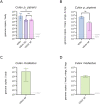Belgian Culex pipiens pipiens are competent vectors for West Nile virus while Culex modestus are competent vectors for Usutu virus
- PMID: 37729233
- PMCID: PMC10545110
- DOI: 10.1371/journal.pntd.0011649
Belgian Culex pipiens pipiens are competent vectors for West Nile virus while Culex modestus are competent vectors for Usutu virus
Abstract
Background: West Nile virus (WNV) and Usutu virus (USUV) are emerging arthropod-borne viruses (arboviruses) in Europe transmitted by Culex mosquitoes. In Belgium, it is currently unknown which Culex species are competent vectors for WNV or USUV and if these mosquitoes carry Wolbachia, an endosymbiotic bacterium that can block arbovirus transmission. The aims of our study were to measure the vector competence of Belgian Culex mosquitoes to WNV and USUV and determine if a naturally acquired Wolbachia infection can influence virus transmission.
Methodology/principal findings: Female Culex mosquitoes were captured from urban and peri-urban sites in Leuven, Belgium and offered an infectious bloodmeal containing WNV lineage 2, USUV European (EU) lineage 3, or USUV African (AF) lineage 3. Blood-fed females were incubated for 14 days at 25°C after which the body, head, and saliva were collected to measure infection, dissemination, and transmission rates as well as transmission efficiency. Mosquito species were identified by qRT-PCR or Sanger sequencing, the presence of infectious virus in mosquitoes was confirmed by plaque assays, and viral genome copies were quantified by qRT-PCR. Culex pipiens pipiens were able to transmit WNV (4.3% transmission efficiency, n = 2/47) but not USUV (EU lineage: n = 0/56; AF lineage: n = 0/37). In contrast, Culex modestus were able to transmit USUV (AF lineage: 20% transmission efficiency, n = 1/5) but not WNV (n = 0/6). We found that the presence or absence of Wolbachia was species-dependent and did not associate with virus transmission.
Conclusions/significance: This is the first report that Belgian Culex mosquitoes can transmit both WNV and USUV, forewarning the risk of human transmission. More research is needed to understand the potential influence of Wolbachia on arbovirus transmission in Culex modestus mosquitoes.
Copyright: © 2023 Soto et al. This is an open access article distributed under the terms of the Creative Commons Attribution License, which permits unrestricted use, distribution, and reproduction in any medium, provided the original author and source are credited.
Conflict of interest statement
The authors have declared that no competing interests exist.
Figures






Similar articles
-
Competition between Usutu virus and West Nile virus during simultaneous and sequential infection of Culex pipiens mosquitoes.Emerg Microbes Infect. 2020 Dec;9(1):2642-2652. doi: 10.1080/22221751.2020.1854623. Emerg Microbes Infect. 2020. PMID: 33215969 Free PMC article.
-
Simultaneous Coinfections with West Nile Virus and Usutu Virus in Culex pipiens and Aedes vexans Mosquitoes.Transbound Emerg Dis. 2023 Mar 29;2023:6305484. doi: 10.1155/2023/6305484. eCollection 2023. Transbound Emerg Dis. 2023. PMID: 40303695 Free PMC article.
-
Mosquito surveillance of West Nile and Usutu viruses in four territorial units of Slovakia and description of a confirmed autochthonous human case of West Nile fever, 2018 to 2019.Euro Surveill. 2021 May;26(19):2000063. doi: 10.2807/1560-7917.ES.2021.26.19.2000063. Euro Surveill. 2021. PMID: 33988125 Free PMC article.
-
Mosquito species involved in the circulation of West Nile and Usutu viruses in Italy.Vet Ital. 2017 Jun 30;53(2):97-110. doi: 10.12834/VetIt.114.933.4764.2. Vet Ital. 2017. PMID: 28675249 Review.
-
Potential transmission of West Nile virus in the British Isles: an ecological review of candidate mosquito bridge vectors.Med Vet Entomol. 2005 Mar;19(1):2-21. doi: 10.1111/j.0269-283X.2005.00547.x. Med Vet Entomol. 2005. PMID: 15752172 Review.
Cited by
-
UK mosquitoes are competent to transmit Usutu virus at native temperatures.One Health. 2024 Oct 13;19:100916. doi: 10.1016/j.onehlt.2024.100916. eCollection 2024 Dec. One Health. 2024. PMID: 39497950 Free PMC article.
-
Laboratory evidence on the vector competence of European field-captured Culex theileri for circulating West Nile virus lineages 1 and 2.Parasit Vectors. 2025 Apr 5;18(1):132. doi: 10.1186/s13071-025-06763-6. Parasit Vectors. 2025. PMID: 40188104 Free PMC article.
-
Is Culex modestus a New Usutu virus vector?Parasit Vectors. 2024 Jul 2;17(1):285. doi: 10.1186/s13071-024-06360-z. Parasit Vectors. 2024. PMID: 38956650 Free PMC article.
-
Culex-Transmitted Diseases: Mechanisms, Impact, and Future Control Strategies using Wolbachia.Viruses. 2024 Jul 15;16(7):1134. doi: 10.3390/v16071134. Viruses. 2024. PMID: 39066296 Free PMC article. Review.
-
Mosquitoes in urban green spaces and cemeteries in northern Spain.Parasit Vectors. 2024 Apr 2;17(1):168. doi: 10.1186/s13071-024-06263-z. Parasit Vectors. 2024. PMID: 38566167 Free PMC article.
References
-
- European Centre for Disease Prevention and Control. Weekly updates: 2022 West Nile virus transmission season n.d. https://www.ecdc.europa.eu/en/west-nile-fever/surveillance-and-disease-d... (accessed May 5, 2023).
-
- European Centre for Disease Prevention and Control. Historical data by year—West Nile virus seasonal surveillance n.d. https://www.ecdc.europa.eu/en/west-nile-fever/surveillance-and-disease-d... (accessed May 5, 2023).
Publication types
MeSH terms
Supplementary concepts
LinkOut - more resources
Full Text Sources
Medical

